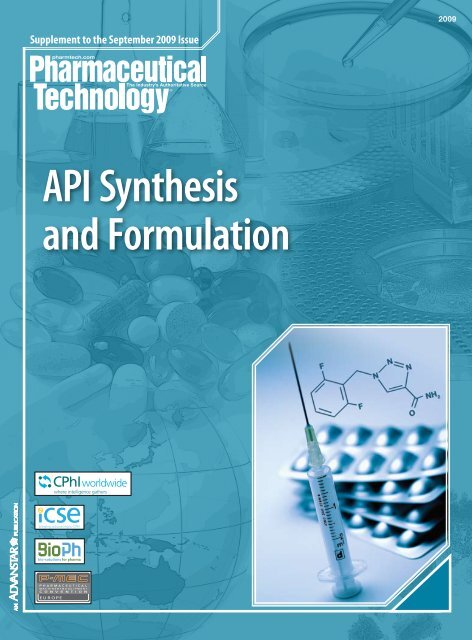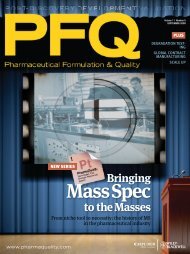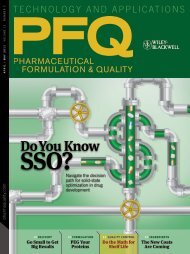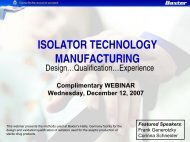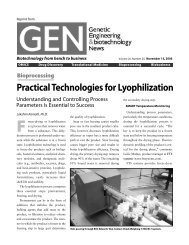Moving from Vials to Prefilled Syringes - Sterile Parenteral Drug ...
Moving from Vials to Prefilled Syringes - Sterile Parenteral Drug ...
Moving from Vials to Prefilled Syringes - Sterile Parenteral Drug ...
You also want an ePaper? Increase the reach of your titles
YUMPU automatically turns print PDFs into web optimized ePapers that Google loves.
2009Supplement <strong>to</strong> the September 2009 IssueAPI Synthesisand FormulationE U R O P E
Table III: Filing requirements for prefilled syringes.Attribute*Container–closureMove <strong>from</strong> liquid vialMove <strong>from</strong>lyophilized vialSimilar? Refer <strong>to</strong> previous extractableand leachable studies <strong>to</strong> impart lubricity.Siliconization may be needed.Formulation No change. Change <strong>from</strong>freeze-dried powder<strong>to</strong> liquid.S<strong>to</strong>rageconditionsNo change.A stability study thatcollects 3 months ofcomparative accelerateddata and long-term dataof at least 1 batch (3 maybe required).A clinical study isrequired if degradationor impurities profileschange.May change.A stability study thatcollects 3 monthsof comparativeaccelerated andlong-term data on 3batches.A clinical study isrequired if degradationor impurities profileschange.*Changes in indication and routes of administration requiressubmission of clinical data <strong>to</strong> authorities.must be considered <strong>to</strong> ensure sterility of the product and <strong>to</strong> avoidparticulate contamination.Third, materials in the proposed syringe must be compared withthose of the current vial. The analysis should consider whether:• The material in the proposed syringe, including in thecontainer, plunger device, and closure system, protectsthe drug product• The syringe system introduces a new material• The system will require any changes <strong>to</strong> the drug productformulation.Choosing a container and closure system made of the samematerials as the vial will eliminate the need for additionalextractable and leachable studies. Any new materials, includingthose in the hub or needle, will need <strong>to</strong> be evaluated instability testing. Extractable studies also must include proposedlabels, adhesive, and ink if the barrel of the syringe isnot made of glass.Stability pro<strong>to</strong>col. FDA rules governing current good manufacturingpractice (GMP) stipulate that companies develop andthoroughly document a testing program <strong>to</strong> assess the stabilitycharacteristics of the drug product (9). Consequently, a companymust define stability testing requirements related <strong>to</strong> thecontainer–closure system. These requirements include how temperature,humidity, and light influence the shelf life of the drugand help <strong>to</strong> determine appropriate s<strong>to</strong>rage conditions and expirationdates for the product. A stability pro<strong>to</strong>col that is specific<strong>to</strong> the molecule and the proposed drug-delivery device must bewritten, implemented, and evaluated <strong>to</strong> assess the stability characteristicsof the molecule in the container–closure system (9).Although some extractable and leachable studies related <strong>to</strong>the dry or liquid vial presentation may be transferable <strong>to</strong> thenew format, some new stability testing is required when movingan injectable therapeutic <strong>to</strong> a prefilled syringe (see TableIII). The long, narrow dimensions of a syringe increase themolecule-<strong>to</strong>-surface-area ratio <strong>from</strong> the previous vial presentation.As a consequence, accelerated and long-term stabilitystudies are necessary <strong>to</strong> determine whether the change affectsthe extractable and leachable parameters and <strong>to</strong> understandthe impurity and degradation profile of the molecule in thecontainer–closure system.The stability pro<strong>to</strong>col should detail the sample size, test intervals,s<strong>to</strong>rage conditions, validated analytical methods <strong>to</strong> beperformed, the container–closure system, test specifications, andnumber of batches required. In addition, reconstitution studies willbe required for parenteral products offered in a kit with a prefilleddiluent syringe or in a dual-chamber prefilled lyophilized syringe.Tests and specifications must be based on knowledge of the degradationpathway for the particular molecule, use validated andstability-indicating methods, and specify limits appropriately.Clinical testing. Clinical studies are required when there is achange in indication or new route of administration for the drug.However, movement <strong>from</strong> a dry or liquid vial <strong>to</strong> a prefilled syringealso necessitates clinical testing if the reformulated drug’sdegradation or impurities profile change.Scenario one: liquid vial <strong>to</strong> liquid prefilled syringeA company markets a contrast imaging agent used in the imagingof major organs. Originally available in 50-mL, 100-mL, and 200-mL single-use vials for intravenous and intra-arterial administration,the company seeks <strong>to</strong> make the product available in 10-mLand 50-mL prefilled syringes for intrathecal administration forimaging the spinal cord and nervous system. The 50-mL syringealso would be used in the previously approved routes of administrationand indication.In this situation, it is important <strong>to</strong> consider which fac<strong>to</strong>rschange and which remain the same. The container–closure systemare new, meaning a new size and dimension of container andnew functionality of the device are involved. Because the devicewould enable administration directly in<strong>to</strong> the spinal cord, theroute of administration is new, as is the indication. The formulationand long-term s<strong>to</strong>rage conditions remain the same, however,because the contrast imaging agent was previously available ina liquid vial.In selecting a syringe system, the company chooses a devicewith components similar <strong>to</strong> those used in the single-use vials.Because the glass and rubber formulation are identical betweenvial and syringe, previous extractable and leachable studies willapply. However, the company must compare all the materialsin the container–closure system because some new materialsmay be introduced in the components. In addition, the syringemay require additional siliconization <strong>to</strong> improve the functionof the plunger.To support the regula<strong>to</strong>ry filing, the company will need <strong>to</strong> submitthree months of comparative accelerated stability data. Longtermdata on at least one batch, possibly three, will be needed at thetime of submission. Moreover, the company will need <strong>to</strong> commit<strong>to</strong> placing the first of three production batches on long-term stabil-
ity and <strong>to</strong> placing another batch on long-term stability each year.Additional clinical data also will be needed <strong>to</strong> support the newindication and the new intrathecal route of administration.Scenario two: lyophilized vial <strong>to</strong> prefilled syringeA company producing a lyophilized product packaged with reconstitutionfluid for intramuscular injection considers marketinga prefilled syringe for the same indication, in the managemen<strong>to</strong>f rheuma<strong>to</strong>id arthritis. The company must reformulatethe molecule <strong>to</strong> a stable liquid. The route of administration willremain the same.The container–closure device, however, will change, whichmeans that some materials and the functionality of the systemwill be different. In addition, long-term s<strong>to</strong>rage conditions maychange because of the new formulation.When evaluating a syringe system, the company mustchoose one with components that are similar <strong>to</strong> those used inthe vial and reconstitution device <strong>to</strong> best leverage previouslyconducted extractable and leachable studies. As with otherprefilled syringes, additional siliconization may be necessary.Clinical studies will be required as well if the degradation orimpurity profile changes.Upon submission, FDA will require three months of comparativeaccelerated data and long-term data on three batches of drugproduct. The stability tests will need <strong>to</strong> focus on appearance,color, clarity, sterility, pyrogens, syringe functionality, container–closure integrity, impurities, and particulates. The company alsowill need <strong>to</strong> commit <strong>to</strong> placing the first three production batchesand annual batches on long-term stability tests.ConclusionThe process of moving an injectable therapeutic <strong>from</strong> a vialpresentation in<strong>to</strong> a prefilled syringe or, perhaps, in<strong>to</strong> an au<strong>to</strong>injec<strong>to</strong>rformat, can be complex, regardless of whether theoriginal product is in a liquid or lyophilized formulation.Companies pursing a new dosage form must carefully documentthe sterility and purity of the product and ensure thestability of the molecule in the new container–closure system.Complexity of the process multiplies when the dosage formis <strong>to</strong> be marketed on a global scale. Countries differ in theinterpretation of regula<strong>to</strong>ry guidelines established throughthe International Conference on Harmonization (10).To ensure a smooth and speedy transition <strong>to</strong> a new dosageform, most companies assign responsibility for the changemanagementprocess <strong>to</strong> a project manager, who coordinatesroles and responsibilities of the team involved in the project,establishes processes and procedures, and manages regula<strong>to</strong>rysubmission timelines. Working with team members, the projectmanager develops and implements the regula<strong>to</strong>ry strategy<strong>to</strong> control and properly validate the effect of new processesand materials on the therapeutic molecule.The project manager also helps <strong>to</strong> select and coordinate theefforts of external partners, including research organizations,suppliers, and manufacturers. The choice of these externalpartners is critical, particularly for companies with limitedexperience with multiple regula<strong>to</strong>ry authorities or with theformulation or manufacturing of therapeutic molecules. Forexample, a contract manufacturing organization with a drugmaster file on record with FDA for its facilities, processes, orother articles used in the manufacturing, processing, packaging,or s<strong>to</strong>rage can help reduce the amount of paperworkthat must be submitted. Moreover, in some instances, havinga fill–and–finish site that passed inspections within the pastyear may limit the need for an additional visit by that inspec<strong>to</strong>ratebefore regula<strong>to</strong>ry approval.When working with injectable therapeutics, the fastest andmost efficient path <strong>to</strong> market for a new delivery device is one inwhich processes are rigorous, documentation is thorough, andteam members are experienced and capable. The project managercan facilitate a smooth transition <strong>to</strong> the new dosage form bydeveloping and carefully implementing the regula<strong>to</strong>ry strategyand by choosing qualified, effective partners.References1. J.A. DiMasi, R.W. Hansen, and H.G. Grabowski, “The Price of Innovation:New Estimates of <strong>Drug</strong> Development Costs,” Jrnl. of Health Econ.22 (2), p. 151 (2003).2. B. Harrison and M. Rios, “Big Shot: Developments in <strong>Prefilled</strong> <strong>Syringes</strong>,”Pharm. Technol. 31 (3) 50–60 (2007).3. Frost and Sullivan, US <strong>Drug</strong> Delivery: Usage Patterns, Preferences andOpportunities in the US—Physicians’ Perspective, Vol. 2, 2008.4. Frost and Sullivan, US <strong>Drug</strong> Delivery: Usage Patterns, Preferences andOpportunities in the US—The Patient’s Perspective, Vol. 1, 2008.5. M. Borlet, “Financial Model for Converting <strong>from</strong> a Vial <strong>to</strong> a Pre-filledSyringe,” in The Universe of Pre-Filled <strong>Syringes</strong> and Injection Devices,presented at PDA, San Diego, CA, 2008.6. T. Polen, “Enhanced Packaging and Reformulations Give New Life <strong>to</strong>Biologics,” BioPharm Int. 19 (10) 60–66 (2006).7. FDA, 21 USC 356a, Sec. 506 A, Manufacturing Changes (Bethesda,MD, 2009).8. R. Gibson, “<strong>Moving</strong> <strong>to</strong> a Pre-filled Syringe: Stability Considerations—A Regula<strong>to</strong>ry Perspective” in The Universe of Pre-Filled <strong>Syringes</strong> andInjection Devices, presented at PDA, San Diego, CA, 2008.9. Code of Federal Regulations, Title 21, Food and <strong>Drug</strong>s (GovernmentPrinting Office, Washing<strong>to</strong>n, DC), Part 211.166.10. K. Davis, “Biopharmaceutical Manufacturing: The Challenge of GlobalRegula<strong>to</strong>ry Compliance,” Pharm. Technol. 32 (2) 60–68 (2008).11. <strong>Drug</strong>s@FDA, www.accessdata.fda.gov/Scripts/cder/<strong>Drug</strong>satFDA/index.cfm?fuseaction=Search.<strong>Drug</strong>Details, accessed July 7, 2009.12. FDA, Approval Letter: Fluzone, Sept. 4, 2002 (updated May 15, 2009),www.fda.gov/BiologicsBloodVaccines/Vaccines/ApprovedProducts/ucm123732.htm, accessed July 8, 2009.13. FDA, Approval Letter—Human Papillomavirus Quadrivalent (Types6, 11, 16, 18) Vaccine, Recombinant, June 8, 2006 (updated May 1,2009), www.fda.gov/BiologicsBloodVaccines/Vaccines/Approved-Products/ucm111283.htm, accessed July 8, 2009.14. FDA, Approval Letter, Feb. 17, 2000 (updated Mar. 4, 2002), www.fda.gov/BiologicsBloodVaccines/Vaccines/ApprovedProducts/ucm137057.htm, accessed July 8, 2009.15. FDA Approved Products, Pneumococcal 7-valent ConjugateVaccine [package insert], Oct. 2008, www.fda.gov/downloads/BiologicsBloodVaccines/Vaccines/ApprovedProducts/UCM137038.pdf, accessed July 8, 2009. PT© Reprinted <strong>from</strong> Pharmaceutical Technology Supplement, September 2009 Printed in U.S.A.


